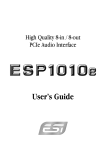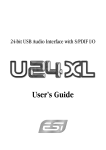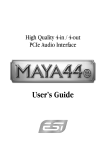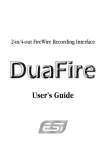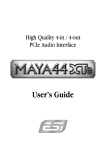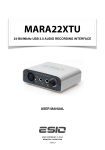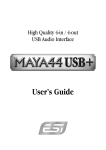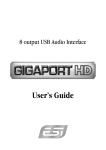Download ESI U46 XL User`s guide
Transcript
4-in/6-out USB Recording Interface User’s Guide ESI - Copyright © 2008 Revision 1, September 2008 www.esi-audio.com U46 XL ESI INDEX 1. Introduction.................................................................................................................................. 4 1.1 What’s in the box ................................................................................................................................................. 4 1.2 Key Features ........................................................................................................................................................ 4 2. Description of U46 XL ................................................................................................................. 5 2.1 Front Panel........................................................................................................................................................... 5 2.2 Rear Panel ............................................................................................................................................................ 6 2.3 Minimum System Requirements.......................................................................................................................... 6 3. Installation .................................................................................................................................... 7 3.1 Windows XP ........................................................................................................................................................ 7 3.2 Windows Vista..................................................................................................................................................... 8 3.3 Mac OS X .......................................................................................................................................................... 10 4. U46 XL Control Panel ............................................................................................................... 10 4.1 Pull Down Menu ................................................................................................................................................ 10 4.2 Input section....................................................................................................................................................... 11 4.3 Output section .................................................................................................................................................... 12 4.4 DirectWIRE ....................................................................................................................................................... 12 5. Audio Applications..................................................................................................................... 15 5.1 Windows Multimedia setup ............................................................................................................................... 15 5.2 Latency setting and ASIO applications under Windows.................................................................................... 15 5.3 Mac OS X Audio MIDI Setup ........................................................................................................................... 15 5.4 Cubase LE 4....................................................................................................................................................... 16 6. Technical Specifications ............................................................................................................ 16 7. General Information .................................................................................................................. 18 3 U46 XL ESI 1. Introduction Thank you for choosing the ESI U46 XL. U46 XL is an ideal mobile recording interface for both laptop and desktop computers. It offers 4 input and 6 output channels in a solid portable and stylish unit. It's the perfect solution for playback and recording applications on the road - all in a rugged and compact package that can travel with you everywhere. The line level inputs and outputs are provided via RCA connectors. There is even a professional microphone input with XLR input, +48V phantom power support and adjustable input gain, a Hi-Z instrument input as well as a headphone output with separate volume control. There is more: U46 XL is bus powered from your PC or Mac, which means that typically no external power supply is needed for its operation. With its EWDM driver interface, U46 XL can be used perfectly with all current audio applications, even including professional recording and DJ programs from various companies. ASIO, MME, WDM, CoreAudio and DirectX support is provided. U46 XL works under Windows and Mac OS X. Even if you are an experienced professional, please take some time to read through this user manual and familiarize yourself with the features and operation of U46 XL. You may also want to refer to your audio software’s documentation to better understand how U46 XL works with your program. 1.1 What’s in the box - U46 XL USB audio interface - Installation and Driver CD - Steinberg Cubase LE 4 DVD - User’s Guide - USB cable 1.2 Key Features - 4-in 6-out multi purpose USB audio interface - 4 line inputs (mono) - XLR microphone input with gain control - +48V phantom power for condenser microphone - direct instrument input for electric guitars (Hi-Z) with gain control - 6 line level analog outputs with separate mix outputs - headphone out with level control - 4 channel recording and 6 channel playback at the same time – Full Duplex - 4-in 6-out at 44.1 kHz, 4-in 4-out at 48 kHz - WDM, MME, ASIO, CoreAudio and DirectSound support - compatible with Windows XP/Vista and Mac OS X 4 U46 XL ESI 2. Description of U46 XL 2.1 Front Panel Channel 1/2 input connector (CH 1/2) - Input source (MIC/LINE) selector: This is where you select input sources of channel 1/2. - MIC IN connector: Connect your microphone to this XLR connector. - +48V phantom power switch: Supply +48V DC phantom power to input channels 1/2 by pressing the button. - GAIN control for microphone input: Control input level of microphone. Channel 3/4 input connector (CH 3/4) - Input source (HI-Z/LINE) selector: This is where you select input sources of channel 3/4. - HI-Z IN connector: Connect an electric guitar or bass guitar to this unbalanced 1/4” connector. Only unbalanced 1/4” phone jack connection is possible via this input. - GAIN control for Hi-Z input: Control the input level of a connected electric guitar via this control knob. Headphone output with volume control (HEADPHONE): Monitor all input sources and output sources through the headphone output. The output level can be adjusted with the control knob. POWER switch: Allows you to turn on / off the unit. 5 U46 XL ESI 2.2 Rear Panel External power supply connector (DC 9V): If you use a microphone that requires phantom power, especially with a laptop computer, it’s strongly recommended to use a DC +9V/500mA adapter (not included). When you turn on U46 XL or when you turn on/off phantom power, the current peak level might go over 500mA. USB connector: Connects the USB cable to the computer. MIX OUT: You can monitor all input sources and output sources through the Mix output. Usually, you can use Mix out to connect to powered monitor speakers. OUTPUT 1~6: You can use these outputs to connect to various external devices with independent playback channels or for a 5.1 surround connection. INPUT 1~4: The line level inputs for line level sources like tape decks, mixer outputs, phono preamps, CD-Players, etc. 2.3 Minimum System Requirements PC - Intel Pentium III 600MHz CPU or equivalent AMD CPU 512 MB RAM Direct X 8.1 or higher Microsoft Windows XP with Service Pack 2 or higher or Microsoft Windows Vista 32-bit one available USB port Mac - 6 Power Macintosh G4 or higher one available USB port 512 MB RAM Mac OS X 10.3 or higher U46 XL ESI 3. Installation Before installing the drivers of U46 XL, we recommend to check on the download section of www.esi-audio.com for updated drivers. 3.1 Windows XP Disconnect U46 XL before you install the driver if it has been connected already. Then launch setup.exe from the Windows folder of the included driver CD or from a download of a recent driver from our website. You will now see a dialog as shown on the left picture below. Click Next. You can define the target directory for the installation now. Confirm it with Next. The installer now informs you that the driver installation will start as shown on the left picture below. Confirm this with Next. During the following process you will see a dialog box once or several times that informs you that the driver software has not passed Windows Logo testing. Please be assured that our drivers have been tested in various different ways and are OK to be used. Confirm any such dialog with Continue Anyway. You will now be prompted to connect and switch on the hardware on the next dialog that is shown below on the left. Plug in U46 XL and switch it on. Do not click Next yet. During the driver 7 U46 XL ESI installation, Windows might again prompt you to confirm the Windows Logo testing dialog once or several times with Continue Anway before the driver installation is finalized. You can now finally click Next on the ESI U46 Audio Driver Setup dialog. The installation is now finished. To confirm this, please check if the ESI icon is displayed in the taskbar notification area as shown below. If yes, the driver installation has been completed successfully. 3.2 Windows Vista Disconnect U46 XL before you install the driver if it has been connected already. Then launch setup.exe from the Windows folder of the included driver CD or from a download of a recent driver from our website. When launching the installation, Windows Vista might prompt a security message. Make sure to allow the installation. You will then see a dialog as shown on the left picture below. Click Next. You can define the target directory for the installation now. Confirm it with Next. 8 U46 XL ESI The installer now informs you that the driver installation will start as shown on the left picture below. Confirm this with Next. During the following process you will see a Windows Security dialog box once or several times that asks you for confirmation to install the driver software. Confirm any such dialog with Install. You will now be prompted to connect and switch on the hardware on the next dialog that is shown below on the left. Plug in U46 XL and switch it on. Do not click Next yet. Instead, wait a few seconds for the automatic device driver installation. You can monitor this in the task notification area where Windows Vista informs that the driver is installed via a bubble message box. You can now finally click Next on the ESI U46 Audio Driver Setup dialog. The installation is now finished. To confirm this, please check if the ESI icon is displayed in the taskbar notification area as shown below. If yes, the driver installation has been completed successfully. 9 U46 XL ESI 3.3 Mac OS X Mac OS X already provides support for class compliant USB audio devices such as U46 XL. This means that no software or driver needs to be installed to use U46 XL under Mac OS X. Simply connect the unit with the supplied USB cable to your Mac and you can start using it. Controlling the basic options of U46 XL under Mac OS X is mainly done via the Audio MIDI Setup utility from Mac OS X described in section 5.3 of this manual. 4. U46 XL Control Panel After successfully installing the U46 XL hardware and driver, you can see the icon on the system tray of the task bar. Clicking on this icon will launch the U46 XL Control Panel. 4.1 Pull Down Menu The U46 XL Control Panel includes a pull down menu section that contains the following main configuration options. Config – Factory Default Returns all U46 XL Control Panel configuration settings to the factory default. Config - Always On Top Enables to display the U46 XL Control Panel always over other windows. If this is not selected, the active windows of other applications will be shown over the U46 XL Control Panel. 10 U46 XL ESI File - Close Window This will close the U46 XL Control Panel window but it will not shut down the control panel. You can always relaunch the control panel by clicking ‘ESI’ icon on the system tray. Help – About Shows information about the driver revision. 4.2 Input section Input This is where you can increase the input level of the analog input 1/2. The input level 3/4 is fixed at 0dB. The number on the bottom indicates the relative level in dB. Input source display This is where you can check current input source selected by the input source selector on the front panel of U46 XL hardware. Monitor This is where you can adjust input monitoring level of U46 XL. Set the level using the mouse, mouse wheel, or cursor keys. The number on the bottom indicates the relative level in dB. You can also select mute button ( ) to mute each monitoring input source. 11 U46 XL ESI 4.3 Output section Output 1/2, 3/4, 5/6 You can individually change levels for all output channels by clicking and dragging the fader bars. The number on the bottom shows the relative amount in dB. You can also select mute button to mute each output channels. Master Output You can adjust all input / output monitoring levels by clicking and dragging the Master fader. Again, the number on the bottom shows you the relative monitoring level in dB. You can also select mute button to mute each output channels. 4.4 DirectWIRE What is DirectWIRE? DirectWIRE is a driver technology, developed by ESI, which can be used for routing audio streams internally within applications using EWDM Audio MIDI Drivers exclusively developed by ESI. With the DirectWIRE router, an application can record from other application’s audio outputs without external wiring or any loss of data when they are running at the same time. DirectWIRE also allows you to easily rip any audio stream in real time by transferring data thru DirectWIRE from MP3s, live On-line Broadcast and On-demand content, and more. DirectWIRE Panel Click on DirectWIRE on the U46 XL control panel. The DirectWIRE panel window as shown below will appear. DirectWIRE digital virtual wiring technology, developed by ESI, routes audio streams internally within applications using standard audio drivers such as WDM, ASIO and MME, even when they are running at the same time. 12 U46 XL ESI The number on the row represents the input or output port. The columns represent ins and outs (on and off) of the respected drivers. Patch the virtual cables from one point to another as you drag your mouse point. INPUT section: It's used to route signals from the card's hardware inputs. MME section represents general application's I/O: Ex.) WinAmp, WaveLab (non ASIO mode), Cakewalk, Audition, Vegas, etc. WDM section represents Multi-MME application’s I/O: Ex.) SONAR (when using WDM/KS), PowerDVD, WinDVD, etc. ASIO section represents ASIO application’s I/O: Ex.) Cubase, Logic, Reason, Nuendo, SONAR (when using ASIO), Samplitude, etc. GSIF section represents GSIF application like GigaStudio. * Some applications support multiple driver modes. DirectWIRE Examples EX1. Recording from WinAmp (MME) to WaveLab (MME) Caution: If you want to record what's played back in WinAmp, but don't want to hear the sound, you should click the OUT button in the MME section so it'll change to OFF. 13 U46 XL EX2. Recording from WinAmp (MME) to SONAR (WDM) EX3. Recording from WinAmp (MME) to Cubase, Logic, Nuendo (ASIO) EX4. Recording from GigaStudio (GSIF) to SONAR (WDM) 14 ESI U46 XL ESI EX5. Recording from GigaStudio (GSIF) to Cubase (ASIO) 5. Audio Applications This chapter contains basic configuration examples for some popular software applications. Please also refer to the manual of the audio software you use for detailed information. 5.1 Windows Multimedia setup The Windows Multimedia setup is required if you want to use your U46 XL system as the main sound device for Windows multimedia applications. Go to My computer-> Control panel -> Sounds and Audio Device Properties -> Audio. Select the U46 XL entry as your playback device to make sure that all standard signals are played via the U46 XL hardware. 5.2 Latency setting and ASIO applications under Windows Via Config > Latency in the Control Panel it is possible to change the latency setting (also called “buffer size”) for the ASIO driver of U46 XL. A smaller latency is the result of a smaller buffer size. Depending on the typical application (e.g. for playback of software synthesizers) a smaller latency is an advantage. At the same time, the best latency setting indirectly depends on the performance of your system. For recording applications, a typical latency buffer size between 128 and 288 samples is standard. The default value is 256. Note that the latency has to be setup before launching the ASIO application using U46 XL. 5.3 Mac OS X Audio MIDI Setup The main control center of U46 XL under Mac OS X is the Audio MIDI Setup application that you can find in your Applications folder. When you launch it, you can setup U46 XL as your Default Input, Default Output or System Output device – if required. While audio production and editing applications usually provide an option inside their preferences to select U46 XL as recording and playback device, many general standard applications such as iTunes for example are usually accessing the Default Output device, selectable in the Audio MIDI Setup dialog. 15 U46 XL ESI If you want to change settings of U46 XL, you need to select it under Properties For as shown in the picture above. You can change the default sample rate under Audio Input -> Format or Audio Output -> Format or you can change the main playback volume under Audio Output -> Volume Slider -> M. 5.4 Cubase LE 4 U46 XL ships with a DVD-ROM with Cubase LE 4 from Steinberg. If you are using a different recording software, you can skip this section. Installation To install Cubase LE 4, insert the DVD-ROM into the DVD-ROM drive of your computer. Under Windows, the installation will normally start automatically – if not, you can launch it manually by starting the installer from the DVD-ROM drive. To install Cubase LE 4 under Mac OS X, double click on the installer icon. To proceed with the installation, follow all instructions on screen. During the installation the Syncrosoft License Control software will be installed as well. To use Cubase LE 4 for more than 30 days, you need to activate it with this software via the internet. This means that you need an active internet connection on the computer you are installing Cubase LE 4. We recommend you to activate the software as early as possible. Initial Setup As most digital audio applications, Cubase LE 4 requires some initial configuration, before it can be used properly with a new audio interface like U46 XL. Start Cubase LE 4 and select Device Setup from the Devices menu. Select VST Audio System on the tree structure on the left part of the window and then make sure to select ESI U46 ASIO as ASIO Driver entry. You can verify your selection by selecting the ESI U46 device on the left. The dialog, now lists all input and output channels. Note that the Control Panel button has no effect. Confirm your changes by clicking OK. After that its time to select the input and output channels. From the Devices menu, select VST Connection. The VST Connections window appears. Configure your input bus in the Inputs tab and your output bus under Outputs. A bus can be either mono or stereo and added with Add Bus. After that you can start using Cubase LE 4 by opening an existing project or creating a new project. The input and output busses you have created can be assigned to the individual tracks of your project. 6. Technical Specifications Interface - USB Spec Ver1.1, USB Audio Class Spec Ver1.0 Software Specifications - OS: Windows, Mac OS X 16 U46 XL ESI - driver: WDM, ASIO driver, CoreAudio support - sampling rate: 44.1 kHz (4 In / 6 Out) 48 kHz (4 In / 4Out) - resolution: 16 bit Analog Input Specifications - 4 channel analog input / line, mic, Hi-Z input support - line input level: -10dBV unbalanced nominal level, +6dBV maximum level - input impedance - Line: 10K ohm Mic: 6.8K ohm Hi-Z: 200K ohm or better - +48V phantom power support for XLR microphone input Analog Output Specifications - 6 channel analog output and mix output - line output level: -10dBV unbalanced nominal level, +6dBV maximum level - output impedance: 100 ohms ADC Specifications - dynamic range: 85dB a-weighted (typical) - frequency response: 20 ~ 20 kHz (+/- 0.25dB max, @ fs=48 kHz) - resolution: 18 bits DAC Specifications - dynamic range: 87dB a-weighted (typical) - frequency response: 20 ~ 20 kHz ((+/- 0.25dB max, @ fs=48 kHz) - resolution: 20 bits Headphone Amp Specifications - output power: 125mW max @ 32 ohm - recommended load impedance: 32 ~ 300 ohm Power Specifications - power consumption: 2.5W (typical) - USB bus powered (500mA maximum) and DC +9V/500mA adapter support 17 U46 XL ESI 7. General Information Trademarks ESI, U46 and U46 XL are trademarks of EGOSYS, Inc. and ESI Audiotechnik GmbH. Windows is a trademark of Microsoft Corporation. Other product and brand names are trademarks or registered trademarks of their respective companies. The FCC and CE Regulation Warning This device complies with Part 15 of the FCC Rules. Operation is subject to the following two conditions : (1) this device may not cause harmful interference, and (2) this device must accept any interference received, including interference that may cause undesired operation. Caution : Any changes or modifications in construction of this device with are not expressly approved by the party responsible for compliance, could void the user's authority to operate equipment. Note: This equipment has been tested and found to comply with the limits for a Class A digital device, pursuant to Part 15 of the FCC Rules. These limits are designed to provide reasonable protection against harmful interference when the equipment is operated in a commercial environment. This equipment generates, uses, and can radiate radio frequency energy and, if not installed and used in accordance with the instruction manual, may cause harmful interference to radio communications. Operation of this equipment in a residential area is likely to cause harmful interference in which case the user will be required to correct the interference at his own expense. If necessary, consult an experienced radio/television technician for additional suggestions. Correspondence For technical support inquiries, contact ESI support online at www.esi-audio.com. Disclaimer All features and specifications subject to change without notice. Parts of this manual are continually being updated. Please check our web site www.esi-audio.com occasionally for the most recent update information. 18


















